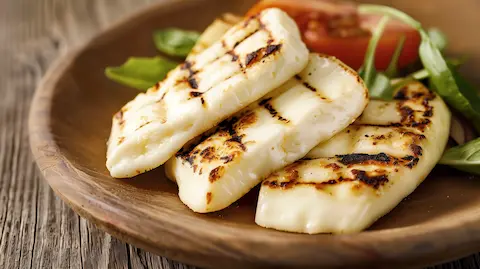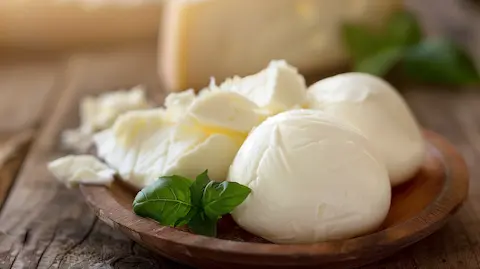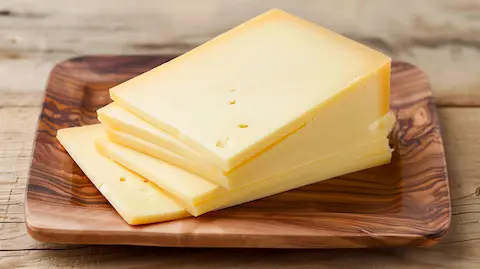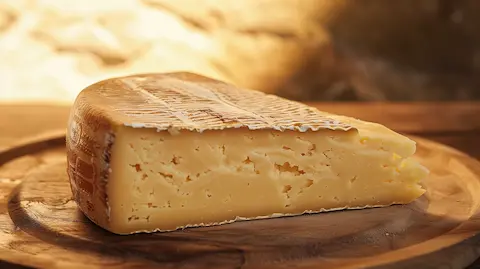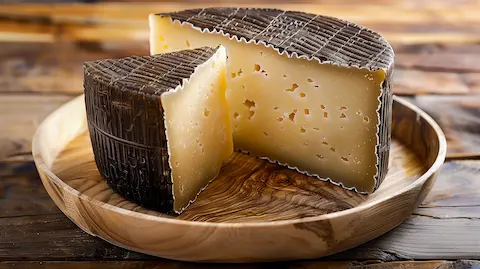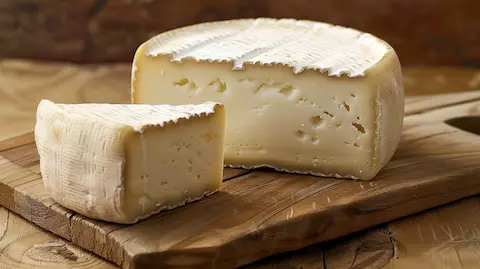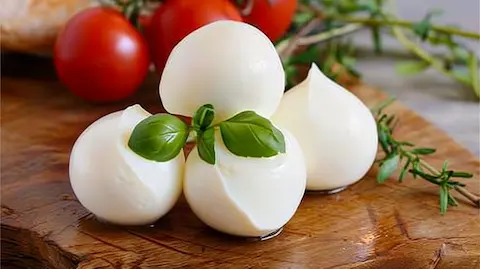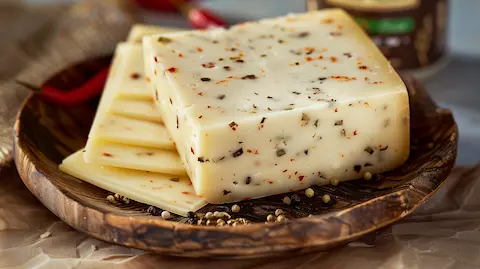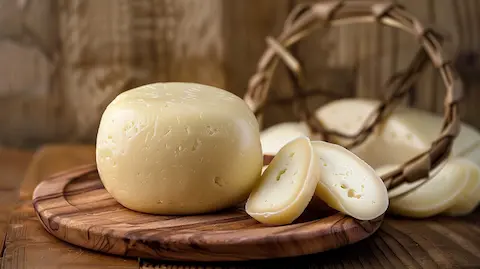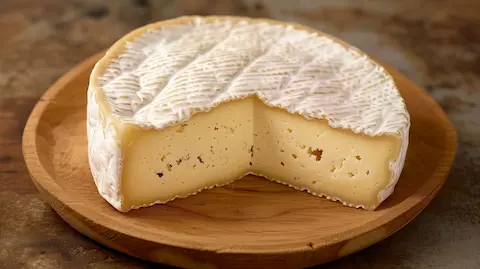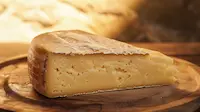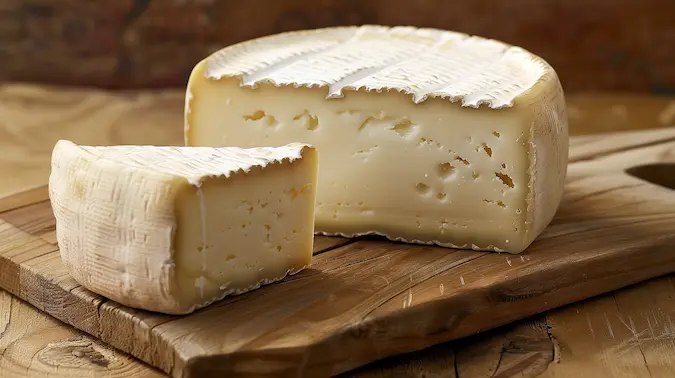What is Taleggio cheese?
Taleggio is a semi-soft, washed-rind cheese from the Val Taleggio region in northern Italy. Known for its strong aroma and rich, buttery flavor, it has a thin crust and a pale yellow, melt-in-your-mouth interior. This cheese is a product of careful aging and traditional methods, with roots tracing back to the 10th century.
Understanding Taleggio begins with recognizing its cultural heritage, acknowledging the meticulous craft of cheesemaking, and appreciating its place in culinary traditions. These aspects form the backbone of Taleggio's identity, influencing its production and consumption worldwide.
Let's now explore how taleggio cheese is crafted.
How is Taleggio cheese made?
Taleggio cheese is made using a traditional process that begins with pasteurized cow's milk. The milk is heated and then curdled with the addition of rennet. The curds are cut, allowing whey to separate, and are then placed in molds. The cheese is salted, sometimes by hand, and aged for about six to ten weeks. During this time, it is washed with a brine solution to prevent mold growth and to form the distinctive rind, while also promoting the development of its unique flavor and texture.
Here is a detailed look at the Taleggio cheese production process:
Production Process of Taleggio Cheese
| Step | Ingredient/Method | Description |
|---|---|---|
| 1. Curdling | Pasteurized cow's milk, Rennet | Milk is warmed and curdled with rennet to form curds and whey. |
| 2. Cutting Curds | Curds | Curds are cut to encourage whey separation and curd maturation. |
| 3. Molding | Curds | Curds are placed into molds to shape the cheese. |
| 4. Salting | Salt | Cheese is salted to enhance flavor and preservation. |
| 5. Aging | Temperature and humidity control | Cheese is aged for 6-10 weeks in controlled conditions. |
| 6. Washing | Brine solution | Cheese is regularly washed with brine to develop the rind and flavor. |
Taleggio cheese profile
Every cheese has its own story, and Taleggio's is written through its characteristics. Below is a profile that captures the essence of this storied cheese without revisiting its taste, which has already been described.
- Made from: Pasteurized cow's milk
- Country of origin: Italy
- Region: Val Taleggio, Lombardy
- Family: Washed-rind
- Type: Semi-soft
- Texture: Creamy and melting
- Rind: Thin, washed
- Colour: Pale yellow
- Aroma: Strong and pungent
- Vegetarian: No, traditional Taleggio uses animal rennet
- Producers: Various, including artisanal and larger-scale dairies
- Safe for dogs: Not recommended due to lactose content and strong flavors
- PDO status: Protected Designation of Origin since 1996
How to store Taleggio cheese?
Proper storage of Taleggio cheese is vital for maintaining its quality and extending its shelf life. Taleggio should be kept in the refrigerator, wrapped in parchment paper, and placed in a loose-fitting plastic bag to allow the cheese to breathe while retaining humidity. This method helps to preserve the cheese's texture and prevent it from drying out.
- Step 1: Wrap - Encase Taleggio in parchment paper to protect its surface.
- Step 2: Bag - Place the wrapped cheese in a loose-fitting plastic bag.
- Step 3: Store - Keep the bagged cheese in the refrigerator, ideally in the vegetable drawer where humidity is higher.
- Step 4: Check - Regularly inspect the cheese for any signs of spoilage and consume within a reasonable time frame.
How long does Taleggio cheese last?
Taleggio cheese's shelf life depends on proper storage conditions. When stored in the refrigerator, it can last for several weeks. If frozen, which is not recommended due to texture changes, Taleggio can last for a few months. Freezing can alter the creamy texture, leading to a crumbly consistency upon thawing, and may also affect the taste.
| Storage Location | Expected Shelf Life | Texture After Thawing | Taste Alteration |
|---|---|---|---|
| Refrigerator | Up to 3 weeks | N/A | Minimal |
| Freezer | Up to 6 months | Crumbly | Possible |
Next, we will explore alternatives to Taleggio cheese for those seeking different flavors or textures.
Can you freeze Taleggio cheese?
Yes, you can freeze Taleggio cheese, but doing so may impact its quality. Freezing can affect the creamy texture of Taleggio, often resulting in a crumbly texture once thawed. Additionally, the taste may be altered. For these reasons, freezing is not recommended unless necessary for extending its shelf life beyond the typical refrigerator storage time.
Alternatives to Taleggio cheese
For those who seek a different taste or cannot find Taleggio, several cheeses offer similar qualities. These alternatives provide a range of flavors and textures that can complement various dishes.
Substitutes for Taleggio Cheese
| Cheese | Origin | Texture | Flavor | Why a Good Substitute |
|---|---|---|---|---|
| Brie | France | Soft, creamy | Mild, buttery | Similar texture and mild flavor; melts well |
| Fontina | Italy | Semi-soft | Rich, nutty | Comparable texture and good melting properties |
| Gorgonzola | Italy | Soft, crumbly | Strong, pungent | Intense flavor for those who enjoy a stronger cheese |
| Havarti | Denmark | Semi-soft | Buttery, slightly acidic | Creamy texture and mild taste make it a versatile substitute |
| Robiola | Italy | Soft | Tangy, milky | Smooth texture and tanginess provide a similar mouthfeel |
Next, we will explore how to use Taleggio in various culinary creations.
How to use Taleggio cheese
Taleggio cheese's creamy texture and robust flavor make it a versatile ingredient in the kitchen. It melts beautifully, making it perfect for enriching risottos, topping burgers, or becoming the gooey center of grilled sandwiches. When slicing Taleggio for use in recipes, it's best to cut it while cold for cleaner edges, then allow it to reach room temperature to fully express its flavor and texture.
- Melting into polenta for a creamy consistency
- Enhancing flavor in pasta dishes like macaroni and cheese
- Adding depth to meat-based sauces
- Creating a rich filling for stuffed chicken or pork dishes
- Pairing with fruits and nuts for a balanced cheese board
How to serve Taleggio cheese
Serve Taleggio at room temperature to maximize its creamy texture and deep flavors. It pairs well with a variety of accompaniments such as figs, pears, and crusty bread, and can be enjoyed with a glass of full-bodied red wine or a light, fruity white wine.
Recipes using Taleggio cheese
Taleggio's melting properties and savory flavor make it ideal for a variety of recipes.
- Polenta with Taleggio and Mushrooms: The cheese's creaminess complements the earthy tones of mushrooms.
- Taleggio and Pear Pizza: Its robust flavor pairs well with the sweetness of pears.
- Grilled Taleggio Sandwich: Taleggio's meltability creates a luxurious texture perfect for a gourmet grilled cheese.
- Stuffed Chicken Breast with Taleggio: The cheese adds a rich depth to the chicken's mild taste.
- Risotto al Taleggio: Taleggio brings a creamy, buttery dimension to this classic Italian dish.
Next, we provide nutritional information on Taleggio cheese.
Taleggio cheese nutrition data
Nutritionally, Taleggio cheese provides a rich source of protein and calcium, though it is also high in fat and sodium. There are 293 calories in Taleggio cheese per 100g. Here's a breakdown of its nutritional content:
| Nutrient | Amount per 100g | % Daily Value* |
|---|---|---|
| Calories | 293 | 14.65% |
| Total Fat | 24g | 36.92% |
| Saturated Fat | 15g | 75% |
| Cholesterol | 90mg | 30% |
| Sodium | 800mg | 33.33% |
| Total Carbohydrate | 0.5g | 0.17% |
| Dietary Fiber | 0g | 0% |
| Sugars | 0.5g | N/A |
| Protein | 18g | 36% |
| Calcium | 500mg | 50% |
| Iron | 0.2mg | 1.11% |
*Percent Daily Values are based on a 2,000 calorie diet. Your daily values may be higher or lower depending on your calorie needs.
Next, we provide insights from WhatCheese on the future of Taleggio and its place in the world of cheese.
What's next? WhatCheese insights
As the founder of WhatCheese, I've seen the cheese industry evolve and adapt to new trends and demands. Taleggio cheese, with its rich history and unique flavor profile, continues to hold a special place in the hearts of cheese enthusiasts. If you are looking to purchase Taleggio, specialty cheese shops and high-end grocers often carry this Italian delight. I recommend seeking out retailers that source directly from Lombardy dairies to ensure authenticity and quality.
For a truly immersive experience, renowned vineyards in the Lombardy region offer cheese tastings that showcase Taleggio alongside local wines. These pairings highlight the harmony between the region's terroir-driven wines and its storied cheeses. Events like the "Lombardy Cheese and Wine Festival" celebrate this synergy, offering a curated selection of pairings in a festive atmosphere.
Additionally, cheese-making workshops and festivals are fantastic avenues to deepen one's appreciation for Taleggio. These events often feature cheesemongers and producers who share their expertise and passion, providing valuable insights into the world of artisanal cheese production.
Notable Cheese Events in Lombardy
| Event Name | Location | Date | Occurrence |
|---|---|---|---|
| Lombardy Cheese and Wine Festival | Bergamo, Lombardy | September 10-12 | Yearly |
| Artisanal Cheese Making Workshop | Milan, Lombardy | Various dates | Monthly |
| Val Taleggio Cheese Tasting Tour | Val Taleggio, Lombardy | May to October | Daily during season |
Let's now explore unanswered questions about Taleggio cheese.

